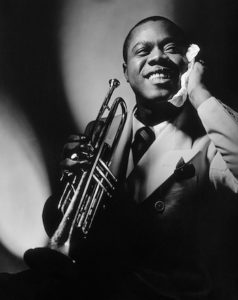
Louis Armstrong
*This date, 1901, marks the birth of Louis Armstrong. He was a Black jazz cornet and trumpet player, singer, band leader, and entertainer.
Born Louis Daniel Armstrong, he was raised by his mother in the urban slums of New Orleans, Louisiana. As a youth, he was jailed for delinquency at the Colored Waifs' home in New Orleans. He was given a cornet to play in the home's brass band. In 1922, Armstrong joined “King Oliver and his Creole Jazz Band” in Chicago and made his first recordings with Oliver the following year.
After 1925, Armstrong began leading his band and recorded with some of the most renowned blues singers, including Bessie Smith. From 1925 to 1928, he led a recording group called the “Hot Fives“(later known as the Hot Sevens.) Their recordings are considered some of the most seminal and enduring pieces in the history of jazz. In the 1930s and 1940s, Armstrong led a big band, toured Europe several times, and increasingly pursued a career as a popular entertainer in motion pictures. In 1947, Armstrong formed a septet called the All-Stars.
This band, which Armstrong led until 1968, essentially became a vehicle for his playing and singing. He became an unofficial musical ambassador from the United States, performing worldwide. In 1964, his "Hello Dolly" recording became the number-one song on the Billboard magazine popular record charts, replacing "I Want to Hold Your Hand" by the British rock music group The Beatles. That same year, Armstrong won a Grammy Award for "Hello Dolly. “
Armstrong became one of the most innovative and influential musicians of the 20th century and one of the most beloved entertainers in the world. Louis Armstrong died in 1971. In 1996, Queens College announced plans to turn Armstrong's home into a museum in the Queens borough of New York City. Also, in his honor, Armstrong's archives are preserved at Queens College.
Africana The Encyclopedia of the African and
African American Experience
Editors: Kwame Anthony Appiah and Henry Louis Gates Jr.
Copyright 1999
ISBN 0-465-0071-1